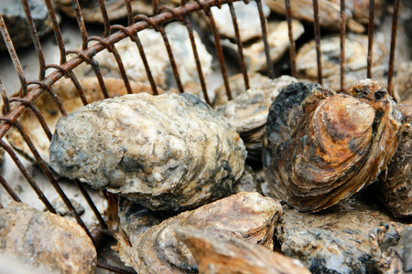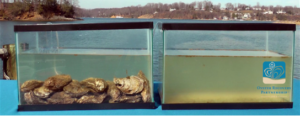Oysters: Their Past, Present, and Future- All Because of Us!
By Sabrina Mowery, Education Volunteer and Youth Action Council Member
Hi, my name is Sabrina and I’m a Norfolk, Virginia native with an appreciation for oysters. Even though I don’t love the salty, slimy taste that is a delicacy to some people, I can acknowledge the crucial benefits that they provide to the Chesapeake Bay.

Basket of Oysters harvested from the Chesapeake Bay
Even if you have had the opportunity to enjoy some local oysters, chances are you aren’t fully aware of their deeply rooted history here in Hampton Roads. Oysters have been harvested by Native Americans in the area for thousands of years. Although they were consuming significant amounts of these shellfish, it wasn’t enough to drastically impact the population, especially compared to our consumption today.
However, that started to change with the arrival of Captain John Smith and the settlers in the early 17th century. They followed the example set by native americans, eating oysters in notable amounts. But, unlike the Native Americans before them, the English settlers were collecting oysters shells to create building materials, like lime mortar. As the population of settlers grew, the harvesting of oysters expanded with it. As you might expect, this consumption led to thousands of years of oyster growth being collected and consumed in a very short time period.

1874 Oyster dredge
By the early 1800’s, New England fishermen had brought dredging equipment down to the Chesapeake Bay, allowing them to rapidly harvest oysters in massive amounts. An oyster dredge, as shown in the picture above, would be attached to the back of a ship and dragged across the bay floor. While this method did collect oysters quite efficiently, it also tore up everything else along the bay floor. Thousands of years of oyster growth and development were being destroyed in a ridiculously short amount of time, with no real efforts made to reduce or repair the damage being done.
Thankfully, this began to change in Virginia around the turn of the 21st century. Organizations across coastal Virginia and around the Chesapeake Bay began a large-scale oyster restoration effort. Organizations, like the Chesapeake Bay Program and the Junior Scientist program at Nauticus, have been working to foster new oysters and educate people about the role they play in our ecosystem. While the focus of oysters in the past was their farming and consumption, now attention was being directed to their preservation and restoration.
Even though you may not have seen the impact of their work, these organizations’ efforts have already led to the restoration of 2% of the original amount of oysters found in the bay, as of 2020. This is significant progress towards returning the bay to its former glory. Oysters play a key role in the bay’s ecosystem and our lives near the bay. They contribute by filtering the water, providing a habitat to nearly 300 species of marine creatures, and helping to reduce erosion. Without them, our lives and homes simply wouldn’t be the same.
As I said, Oysters are major filters for the bay. Each of these molluscs are so efficient that they can filter up to 50 gallons of water every 24 hours. As they filter-feed on microscopic plankton, they clean the water and remove excess nitrogen. Without the oysters to filter the water and remove nitrogen, the water quality would decline and algae would bloom out of control. Although small, reasonable amounts of nitrogen are needed for plant growth, excess can overwhelm bodies of water and ultimately reduce oxygen levels. This can make an area unsafe to swim or harvest in. Even if you may not care about oysters themselves, their function as filters that allows you to enjoy the bay’s water freely are a perfect reason to support them.

Caption: This photo shows you just how efficient oysters are. In just 5 hours, 20 mature oysters transformed that tank of water from murky to clear!
Oysters might not be your first thought when you think of a home, but the numerous species that live within the reefs think of them as just that. Baby oysters, or spat, like to grow right on top of other oysters. This leads to the creation of massive oyster reefs, which play host to more than 300 different species. Some creatures, like sea anemones, serve as food sources for commercially valuable fish. While others, like anchovies and blue crab, make use of the safe space as a nursery for their young. Without the massive structures created by oysters, hundreds of species wouldn’t have a place to forage for food, raise their young, and spend their lives. This could mean less crabs and commercially valuable fish, making them harder to get a hold of, increasing their prices, and reducing the number of jobs created by their harvest. So, for the sake of economically attainable cuisine and numerous local jobs, it’s in our best interest to help rebuild our oyster reefs.

The last house of Holland island in the Chesapeake bay, eaten up by erosion
Erosion is a major issue, especially in coastal areas. This includes land around the Chesapeake Bay. It threatens thousands of homes and businesses, although many are already taking action to protect themselves. Some of their options include elevating buildings and planting vegetation to hold down loose sediments. While these are effective methods, and a step in the right direction, many people overlook the bay’s natural stabilizers. Oysters and their reefs form over top of the seabed and it’s sediments which prevents wave action from washing them away in such massive amounts. Oysters are perfect for this job and have been functioning as a natural barrier for thousands of years. If you are going to invest in methods to keep your property safe from erosion, oysters are a perfect choice that come with many other benefits, like cleaning the water and providing habitat to sea life. If you care about keeping your property and coastal land safe, you should work to care about our natural protectors, the oysters themselves.
Now that you know just how much oysters do for you, let’s figure out how we can help them!
- Throw away litter
Much of the litter you see is plastic, which creates damaging microplastics as it breaks down. This pollutes waterways and is nearly impossible to filter out, even for oysters. In order to make oyster’s jobs as filters easier, please pick up your trash and dispose of it properly.
- Scoop and properly dispose of pet poop
Make sure to scoop up your pet’s poop! Pet waste that is left to be washed away is full of bacteria, diseases, and pollutants. The waste may disappear from your lawn, but the bacteria, diseases and pollutants show up in the bay. That is where it hinders oyster growth and riddles the population with diseases.
- Limit fertilizer use
As I mentioned earlier, the excess nitrogen from fertilizer can wreak havoc on the bay. I encourage you to limit or even eliminate fertilizer use. You will help lighten the workload for our oysters and make the bay safe for fishing, harvesting , and all sea life.
- Don’t eat oysters!
If less people are buying and consuming oysters, there is less reason for suppliers to collect them. With less oysters being collected, the population can make more progress on increasing it’s numbers.
- Donate or recycle oyster shells
Many organizations, such as the Chesapeake Bay Program, will collect oyster shells from restaurants to be used for restoration efforts. Please do your research to make sure that if you do eat oysters, the shells will be recycled and put towards their recovery.
- Educate yourself and others about oyster restoration as much as possible
Please spread the word! Everything that you have learned by reading this blog can encourage others to help as well. Talk to your friends and family about oyster restoration, remember all the good things they do for you, and try to make some changes to help them! The more people that are aware of this issue, the better chance we have to make real progress for the bay and all of it’s oysters.
Most of these suggestions are simple changes that you can incorporate into your daily life. Although more drastic and expensive measures can be taken, each of your small contributions will make a difference!
When Captain John Smith and the first settlers arrived in the early 17th century, they spearheaded the depletion of thousands of years of oyster growth. Since then, we have determined their fate through our actions and choices. Some of those choices have led to great progress, but we have to make sure that we are doing everything we can to foster their recovery and revival. Each of our contributions, no matter how insignificant they may seem, will help the population. Please do what you can to make a difference, if not for the sake of the oysters themselves, then for all of the wonderful benefits they continually bestow upon us.
Now, please go and help the Chesapeake Bay oysters- they need our help just as much as we need theirs!
Sources
NOAA Fisheries. “Oyster Reef Habitat.” NOAA Fisheries, NOAA, 27 July 2020, www.fisheries.noaa.gov/national/habitat-conservation/oyster-reef-habitat.
Koenig, Erin. “Can Clams and Oysters Help Clean Up Waterways?” Woods Hole Oceanographic Institution, Ocean US Magazine, 22 Jan. 2018, www.whoi.edu/oceanus/feature/can-clams-and-oysters-help-clean-up-waterways/.
Schulte, David M. “History of the Virginia Oyster Fishery, Chesapeake Bay, USA.” Frontiers, Frontiers, 18 Apr. 2017, www.frontiersin.org/articles/10.3389/fmars.2017.00127/full.
Volety, Aswani K. “Habitat: Oyster Reefs.” Oyster-Restoration.org, Florida Gulf Coast University, www.oyster-restoration.org/wp-content/uploads/2012/06/MARES_ICEM_SWFS_TechMemo_FINAL_Appdx__HabitatOysterReefs.pdf.
Photo sources:
Basket of oysters harvested from the Chesapeake bay (submitted separately as jpg)
Smith, Stephanie. “Basket of Oysters Harvested from the Chesapeake Bay.” Chesapeake Bay Program, 2 Oct. 2016, www.chesapeakebay.net/news/blog/oyster_populations_show_improvement_in_maryland_sanctuaries_study_finds.
1874 Oyster dredge photo (submitted separately as jpg)
Lockwood, Rev. Samuel. “Popular Science Monthly/Volume 6/November 1874/The Natural History of the Oyster I.” Popular Science Monthly/Volume 6/November 1874/The Natural History of the Oyster I – Wikisource, the Free Online Library, Popular Science Monthly, en.wikisource.org/wiki/Popular_Science_Monthly/Volume_6/November_1874/The_Natural_History_of_the_Oyster_I.
The last house of Holland Island in the Chesapeake bay, Eaten up by erosion (submitted separately as jpg)
Ridgely, Shawn. “The Last House of Holland Island in the Chesapeake Bay, Eaten up by Erosion.” Chesapeake Bay Foundation, cbf.typepad.com/bay_daily/2010/10/the-last-house-on-holland-island-has-fallen-the-iconic-wooden-home-which-became-a-symbol-of-the-impact-of-rising-sea-level.html.
Oyster filtered water (submitted separately as jpg)
Oyster Filtration Video. 26 July 2018, oysterrecovery.org/blog/oyster-filtration-video/.
